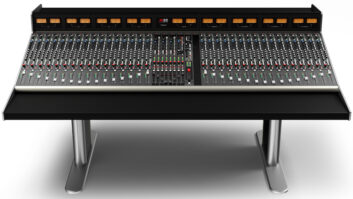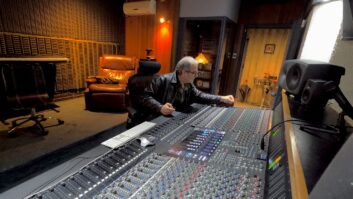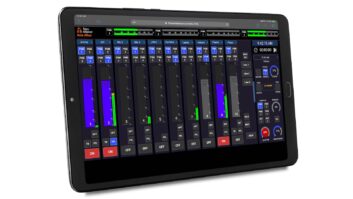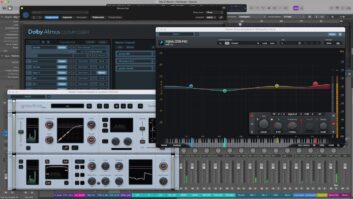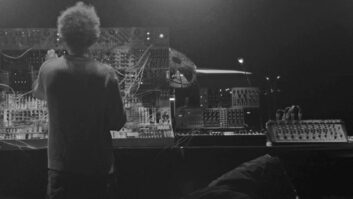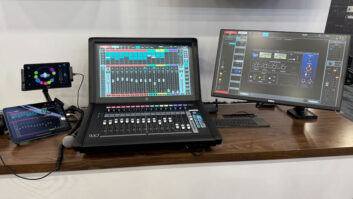Almost any emphatic statement about audio will produce an equally emphatic contradiction. However, most audio engineers agree that Rupert Neve knows how to design great-sounding gear. The latest demonstration of Neve’s touch is the Amek 9098i, a large-format recording and mixing console described by Amek as “the last word, from our point of view, in analog consoles.” Since the 9098i’s official launch at last fall’s AES convention, Amek has installed more than a dozen units. For this “Field Test,” Mix sat down at the 9098i at Studio D in Sausalito, Calif.
The 9098i is a 48-bus desk with four stereo buses and 16 aux sends, available in a minimum 24-module frame or any increment of eight channels above that. The center section has the usual selection of master control facilities, including the four stereo bus master faders, LR-CS master faders, machine control, PC keyboard and trackball, monitoring and communications, aux send masters and Master Status buttons. The center section also houses the Central Assignment Panel (CAP), which includes channel selection hardware (a ten-key pad, increment/decrement buttons, channel number and name displays) and a dynamics control section with a 240×64 LCD and “soft” knobs and buttons. Currently, this section is used exclusively for dynamics control; hopefully, Amek will implement other functions for the CAP in the future. A joystick panel also resides in the center section.
The console computer is a 400MHz Intel Celeron-based PC running DoS 6.22. Amek selected DoS as the operating system because of its greater stability in comparison to either Windows or Mac oS. There is an onboard 12.1-inch monitor, as well as a larger external monitor (a 20-inch is shipped standard). The onboard display is effectively useless, as it is very small and is mounted back at the meter bridge. Plan to rely primarily on the outboard display.
Automation is a given, and the board includes touch-sensitive motorized faders for both monitor and channel faders. Two 6-channel monitor returns facilitate A/B (source/tape) comparisons for surround material, but there’s no 5- or 6-channel master compressor. Dynamics are available on all 6 master buses. Either VU or 100-segment LED meters are available. They cost about the same and can be mixed and matched in the same console.
Channel Path
An in-line console, the 9098i’s channel strips have both large- and small-format faders. At the top of the channel strip is a high-quality TLA mic preamp. The channels have input or fader reverse modes so the complete channel and monitor signal paths or just the large and small faders can be swapped.
The routing matrix has 24 bus assign buttons and a 25-48 switch that reassigns the buttons to the upper buses, along with buttons for assigning the ABCD stereo buses or sending the Monitor input to the 48-track matrix.
Stereo inputs have a Width control for the stereo image, which goes from normal to wide by introducing cross-panned, phase-flipped material. This is a very effective feature, especially on ambience or tracks serving ambient-like functions, like synth pads. It would have been useful if the control also allowed narrowing of the stereo image.
The mono EQ is 4-band, with high and low shelving and two parametric mid-bands, plus HP and LP filters. (The stereo EQ is more limited than the mono.) The shelving filters have one of Mr. Neve’s inimitable touches first introduced on the Medici: very gentle, broad boosts called Glow (on the LF shelf) and Sheen (on the HF shelf). It’s a simple idea that’s very well implemented.
The EQ section offers the little goodies one expects at this price range (around $500K), such as a notch and frequency multiplier modes for the mid-bands and flexible splitting of EQ into channel and monitor paths, or into the dynamics sidechain.
The dynamics are Amek’s Virtual Dynamics, first introduced around 1991 for the Mozart console, and dynamics processors are present in both channel and monitor paths. In an analog dynamics processor, the output of the peak/RMS detector is used to trigger the action of the gain control circuitry. In Virtual Dynamics, the peak/RMS detector output is digitized and the “gain control circuitry” consists of one or more digital emulations of analog dynamics control settings. The user can specify a simple compressor, limiter or gate, a more tweaky version of one of these with lots of parameters, or combinations of all of the above, resulting in a single composite control voltage being generated and applied to the VCA.
Currently, there are ten Virtual Dynamics devices defined: three gates, two compressors, one limiter, one expander, two expander/compressor combos and an auto-panner. Amek is working on a compressor/gate combo. Internal jumpers allow the insert return to be the sidechain source for ducking filters in the sidechain and so forth. The auto-panner module provides numerous options for triggering auto-panning.
Although Virtual Dynamics affords flexibility, the dynamics must be controlled from the CAP, rather than via dedicated knobs on each channel. A single set of controls serves to adjust whichever channel is currently selected. My familiarity with computers in music and audio made it easy for me to accept this trade-off. As long as there are knobs that I can grab and I’m not stuck solely with mouse or trackball editing, I don’t really care.
Amek uses onscreen representations of hardware front panels (“virtual front panels”) for the dynamics processors, but the CAP’s dynamics control section also provides physical knobs and buttons, which I would expect to use exclusively. Front panel emulation, though rooted in the understandable desire to make control of the device familiar and easy to understand, is one I personally don’t favor. To me, knobs and buttons are, on the whole, much better physical than virtual controllers, and graphic or text representations of parameter values can be more clear than a picture of a knob. Trying to drag a virtual pot by rolling a trackball while simultaneously holding down a button with the same hand is awkward and, over the long haul, unhealthy. However, there seems no stopping this trend.
Settings for dynamics processors can be saved into libraries, and Amek points to remixers who maintain libraries of auto-panner settings. However, the rate of the LFo cannot be synched to MIDI Clock, a typical remix requirement. But the auto-pan sweep can be triggered by a click, so a remixer could use a sequencer metronome click for triggering. Processor settings cannot be directly copied from channel to channel but must be stored from one channel and then recalled to the other.
Dynamics processing is one of only two circumstances under which audio passes through a VCA in the 9098i (the other being the automation’s VCA Update mode). Compressors can be stereo-linked in odd/even pairs and will perform true stereo compression (i.e., the envelope follower uses the higher of the two channels at any time as opposed to always looking at the left channel).
Auxes
The 9098i’s flexible auxiliary send structure has 16 aux sends per channel, handled in pairs. A channel’s aux send controls can be routed to the 48-track or ABCD buses instead of the aux buses, and can be swapped with the channel’s Monitor fader to automate the aux send level. Returns can also be routed to the 48-track bus, in addition to the LCRS bus.
one of the 9098i’s more clever routing features is the aux bus fold-down. on any channel, any odd/even pair of auxes 9-16 can be folded down into its lower-numbered correspondent (e.g., aux 9/10 can be folded into aux 1/2, and so forth). one use for this is to be able to send both the channel and monitor inputs to the same outboard device, such as an overall reverb.
Panning
The 9098i was designed with surround mixing in mind and, according to Studio D’s co-owner and chief engineer, Joel Jaffe, the feature that has seen the most use is the 9098i’s surround capability. It is expensive and difficult to make an elegant method of surround panning in an analog console, and the 9098i’s surround panning scheme, while not atypical of analog consoles, seemed reminiscent of older stereo desks that were adapted to surround mixing. For a start, what is normally thought of as the master stereo bus in most consoles is the LCRS bus here, but many functions only address the LR leg of it-for example, the monitor path of a channel strip and the aux returns. Nevertheless, Jaffe seems quite comfortable with the system.
The console has four master panning modes: 2-channel stereo, LCRS, LCRSS (stereo surrounds) and 5.1 (stereo surrounds plus subwoofer send). LCRS mode not only activates the CS master fader, but also groups the 48-track buses into 4-track stems.
To pan from the channel fader into LCRS, the board must be put into LCRS status and the LCRS button in the channel pan section engaged. Here, the Pan control becomes an LCR pan, while the other pot-confusingly labeled Channel-essentially becomes a Front/Back control, panning from LCR at one end, through Center and on to Surround only at the other extreme.
For stereo surround modes (LCRSS and 5.1), the output of the F/B pan pot is fed to Cue A, which is used as the stereo surround level and pan controls. At this point, there are three pan pots involved, not to mention level controls.
Subwoofer/LFE signals in 5.1 mode are sent from a channel’s Aux 5 control, which feeds the S legs of the LCRS and 48-track buses, as Cue A is now the stereo surround send.
This panning scheme is usable but rather complex for static panning, and challenging, to say the least, for any dynamic motion. However, an optional panel has two automatable joysticks, each of which can have a signal hard-assigned to it. That is, the joysticks are not controllers but actual audio panners, with the inputs to them patched in the patchbay and the outputs routed through a bus matrix similar to those found on each channel. Thus, only two channels in a mix can be panned under automation or easily moved around the 2-D space. While acceptable for most music needs, this is limiting in film post, which can require many fly-bys and perspective shifts. As the joysticks are not motorized (or touch-sensitive), a 13×13 LED matrix shows the current panning of the signal.
Soloing, Communications, MIDI
The 9098i has a healthy array of soloing options, including PFL, AFL, Check (Solo In Place), solo safe and momentary, latching or interlock modes. The solos are automatable. Communications are also flexible, offering the ability to talk any one or combination of Aux and Cue, LCRS or 48-track buses, plus several talkback options.
The console’s MIDI implementation offers some intriguing uses. The 9098i’s machine control capabilities can be sent as MMC, and it can transmit timecode as MTC. The console can also receive MMC commands. The 9098i automation syncs only to SMPTE timecode, which Amek chose because it allows bit-level resolution (11/480 frame), while MTC resolution is 11/44-frame at best.
Perhaps the 9098i’s most powerful use of MIDI is the Visual Effects (VFX) system, which lets the board’s display, keyboard and trackball be used to adjust parameters in MIDI-controllable outboard effects. Amek provides profiles for about 30 common processors from Lexicon, Eventide, Alesis, Roland and so forth.
Settings created with VFX can be stored with mix automation and even downloaded to the first ten memories in the device under control. Unfortunately, the communication is one-way: It is not possible to carry in a processor from another studio and import those presets to the 9098i for further editing and storage. Likewise, you cannot edit a preset from a processor’s front panel and then import it. It is also not possible for a user to create a VFX profile for a device not currently supported by Amek.
The 9098i’s Cue List can specify transmission of some MIDI events at designated timecodes, including program changes, controller changes, note on/off and sequencer start/stop.
Currently, it is not possible to assign a hardware fader, knob or button to send MIDI, so the 9098i is not well-suited for use as a front end to a DAW.
Automation
The 9098i offers dynamic and snapshot automation for faders and most channel switches; other controls (such as EQ settings) can be captured in a recall snapshot requiring manual restoration. Automation can be written in Write, Touch Write (automation records only while your hand is on the fader) and Update modes. Update mode employs a VCA for relative trimming of automation data, but the moves can then be transferred to the motorized fader so that the audio does not have to run through the VCA. Given the superlative sonics of the board, this ability to gain the value of VCA trimming without the slight fidelity loss of running the audio through the VCA is thoughtful.
Amek has eliminated the need to do an initial automation write pass all the way through a piece of program material by providing the ability for the automation to write to the end of the mix or the next cue.
offline automation editing is list-based and occurs in two screens. The Edit Mix screen deals only with automatable switches and allows editing any individual switch event. Interestingly, timecode can only be altered to the quarter-frame, the same resolution as MTC.
The Process Mix screen is range-oriented as well as list-based. A specified range of automation events can be cut, copied, pasted, swapped, merged and moved in time, and levels can be trimmed by a specified amount in .1dB steps. There is no breakpoint or other graphic editing of level automation, and editing is only performed by specifying a range in this screen, as opposed to being able to directly select individual and/or noncontiguous events. A range cannot be stored, though desired start and end points can be kept as Cue points. Thus, it is not possible to say, “go to verse 2 and record automation” without specifying the start/end points. Amek says that this has been addressed in the latest software revision, with full on- and offline editing.
A crossfade of definable length can be applied when automation levels are edited offline to smooth over any discrepancies resulting from an edit.
Comments
I found my evaluation of the 9098i to be strongly affected by my increasingly frequent use of digital consoles, a comparison that seems unavoidable these days. Digital boards have an edge in control and quantity of features, while analog boards have a sound that is still unequaled, in my experience, by digital consoles.
For example, in high-end digital competitors, there are usually full 4-band EQs for both channel and monitor paths. This is particularly important in post applications. on the other hand, those EQs, in my experience, just don’t sound as pleasing as the 9098i’s did. The 9098i also distinguishes itself from many other analog boards by providing dynamics processing on both channel and monitor paths.
Amek did a nice job of laying out the channel strips to put the most-used control closest at hand, but most analog consoles still require that you move far out of the sweet spot to make adjustments, such as EQ, on a channel at one end of the board. Digital consoles usually allow control of the desired channel to be moved close to the engineer’s position. As mentioned in the discussion of Virtual Dynamics, Amek adopted a “soft console” approach, more typical of digital mixers, for dynamics control.
Although digital consoles often offer extreme flexibility in signal and bus routing, the 9098i is no slouch in this department, with a number of clever and powerful routing options. on the other hand, surround panning can be much more facile on a digital console, as one or two joysticks can usually be used for any and all channels.
In terms of competition from analog boards, the 9098i is up against other more or less traditional analog designs, such as the SSL 9000 J, and the Euphonix series, which are very much a digital “attitude” in an analog console. on the digital side, it faces everything from the SSL Axiom-MT (a digital board with a lot of analog “attitude”) to the Sony oXF-R3 or Neve Capricorn.
So how does it stack up? Feature-wise, it holds its own against its analog competitors but can’t match the large digital boards. Soundwise, it might be equaled, but I doubt it can be beat.
I don’t think the 9098i offers the quantity of facilities required in film post, especially in busing and panning, but it does have a lot of features suitable for broadcast work. As of this writing, all 9098i boards in the U.S. are doing music recording, but broadcast facilities in both Canada and Japan have installed the 9098i. Studio D has also done live broadcasts with the board.
Given this analysis, the 9098i is a fabulous board for tracking music and very good for mixing it. Tracks recorded through a 9098i can sound as good as it gets, and it could impart quite a bit of warmth to digitally recorded tracks in mixdown. Music recording tends to be more about sound than features. If you are looking for the last killer-sounding analog cowboy in the music console roundup, look no further than Amek’s 9098i.
Amek USA, 2740 Magnolia Blvd., Suite 102, Burbank, CA 91505; 818/973-1618; fax 818/973-1622; www.amek.com.

